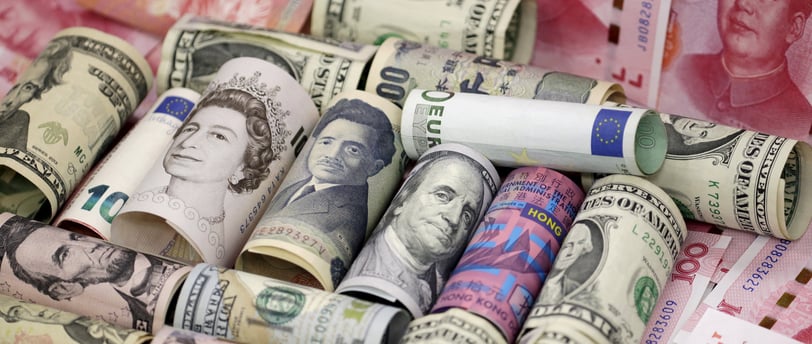Add your promotional text...
Asian Currencies Struggle Amid Dollar Strength and Mixed Chinese Data
Synopsis: Asian currencies started the week on a cautious note, pressured by a robust U.S. dollar ahead of the Federal Reserve meeting and mixed signals from China’s economic recovery. The dollar index hovered near a three-week high, reflecting investor anticipation of a slower rate-cut trajectory in 2025. Meanwhile, subdued retail sales and uncertainties in China’s recovery dampened regional sentiment, with the Chinese yuan and other Asian currencies facing challenges.
FOREX
By Sonal Chauhan
12/16/20243 min read


Asian Currencies Dip as Dollar Holds Near Three-Week High
Most Asian currencies weakened on Monday as the U.S. dollar maintained its strength, bolstered by expectations of a slower Federal Reserve rate-cut path in 2025. The dollar index, which measures the greenback against a basket of six major currencies, edged slightly lower during Asian trading but remained near a three-week peak.
While the Federal Reserve is widely anticipated to cut interest rates by 25 basis points this week, traders expect a cautious pace of rate reductions next year, which continues to lend support to the dollar.
China’s Mixed Economic Data Weighs on Sentiment
The Chinese yuan showed little strength despite Beijing's recent measures to bolster economic growth.
Industrial Production: November data met expectations, reflecting improved business activity due to government stimulus.
Real Estate Stabilization: China’s property sector saw the slowest decline in home prices in 17 months, indicating some stabilization.
Retail Sales Disappointment: Retail sales fell short of forecasts, remaining below last year’s levels, underscoring weak consumer confidence and spending.
The onshore USD/CNY pair climbed 0.2%, with the offshore USD/CNH pair inching 0.1% higher. These movements reflect ongoing concerns about China’s uneven recovery and its ripple effect on the broader Asia-Pacific region.
“Despite policy support, household confidence remains fragile, and recovery in consumer spending may take time,” noted ING analysts. They expect gradual improvements in retail sales growth, potentially gaining momentum in 2025.
Dollar Strength Keeps Asian FX Under Pressure
The U.S. dollar's strength, driven by expectations of a slower pace of rate cuts in 2025, has created headwinds for most regional currencies:
Japanese Yen (USD/JPY): The yen edged up 0.1% amid reports that the Bank of Japan is likely to maintain its interest rate policy, contrary to earlier predictions of a hike.
Singapore Dollar (USD/SGD): The currency inched higher, reflecting the region’s cautious sentiment.
Australian Dollar (AUD/USD): The Aussie gained 0.3%, buoyed by stabilizing commodity prices and improving risk sentiment.
Indian Rupee (USD/INR): The rupee remained steady near last week’s all-time low, reflecting domestic and global pressures.
South Korean Won (USD/KRW): The won weakened as political turmoil heightened after President Yoon Suk Yeol was impeached by parliament over his controversial attempt to impose martial law.
South Korea’s Political Uncertainty Adds to Regional Concerns
The South Korean won faced additional pressure after the impeachment of President Yoon Suk Yeol on Saturday. The country’s finance ministry quickly assured the public of its commitment to implementing market-stabilizing measures to support economic stability amid political uncertainty.
South Korea’s political crisis, coupled with broader concerns over global growth, highlights the fragility of the region’s economic outlook.
Key Drivers to Watch
Several factors are shaping the current market sentiment:
Federal Reserve Meeting:
Investors are closely watching the Fed’s upcoming policy announcement. While a 25-basis-point rate cut is expected this week, the central bank’s outlook for 2025 will be critical in determining the dollar’s trajectory.Chinese Economic Policies:
Beijing’s ongoing efforts to stabilize its economy will remain a key factor for Asian currencies. Analysts are particularly focused on whether promised "vigorous support" for consumption in 2025 will translate into meaningful recovery in retail sales.Global Trade Tensions:
Incoming U.S. President Donald Trump’s plans to impose additional tariffs on China have added a layer of uncertainty. Any further escalation in trade tensions could impact Asian markets and currencies.Regional Central Bank Policies:
Central banks across Asia are navigating the challenges posed by a strong dollar, sluggish global growth, and domestic economic issues. The Bank of Japan, in particular, is under scrutiny for its rate decisions amidst pressure to address economic stagnation.
Outlook for Asian Currencies
The near-term outlook for Asian currencies remains cautious. The U.S. dollar’s resilience, driven by a strong domestic economy and expectations of a measured rate-cut trajectory, poses challenges for regional currencies.
China’s economic recovery remains a key variable. While industrial production and real estate stabilization provide some optimism, weak retail sales and fragile household confidence could delay a broader recovery.
Political uncertainties in South Korea and ongoing global trade tensions further complicate the regional landscape.
Navigating a Complex Landscape
Asian currencies are navigating a challenging environment, shaped by mixed economic signals from China, political upheaval in South Korea, and the Federal Reserve’s cautious policy approach. While the broader economic outlook remains uncertain, targeted policy measures and improving global conditions could offer some support in the months ahead.
As investors assess these dynamics, market participants will be closely watching for signals of stabilization in China and clarity on the Fed’s long-term rate trajectory. For now, the dollar’s dominance continues to cast a long shadow over regional currencies.
